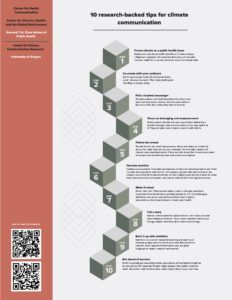Want to be more effective when talking with patients or the public about the health effects of climate change? Try these evidence-backed tips from Ellen Peters, Philip H. Knight Chair and Director of the Center for Science Communication Research at the University of Oregon, and Renee Salas, a climate change and health expert at Harvard T.H. Chan School’s Center for Climate, Health, and the Global Environment and an emergency medicine physician at Massachusetts General Hospital.
Step 1: Frame climate as a public health issue
Emphasize near-term health benefits of climate-change mitigation measures. For example: Everyone will breathe cleaner, healthier air as we transition away from fossil fuels.
Step 2: Co-create with your audience
Don’t assume you know what they need and want-do your research. Then keep testing and iterating as you go along.
Step 3: Pick a trusted messenger
People’s values and identities affect who they trust and how they make choices. So take some time to figure out who the community puts its trust in.
Step 4: Focus on belonging and empowerment
When people identify with an organization delivering a health message, they are more likely to be persuaded by it. They are also more likely to share it with others.
Step 5: Follow the crowd
People tend to do what they perceive others are doing or should be doing. So make that part of your message. For example, people will choose more meatless meals if they are told about the increasing number of people who are limiting their own meat consumption.
Step 6: Harness emotion
Feelings are powerful. They alter perceptions of risk and compel people to act. They can also stop people in their tracks. For example, people who get worried or are anxious when they think about climate can feel helpless and out of control. So show them both reasons to be hopeful and how to channel their feelings into action.
Step 7: Make it visual
Show, don’t tell: Pictures and videos induce stronger emotional responses than words alone, priming people to act. Visual imagery also helps our brains understand abstract and complex associations, like those between climate and health.
Step 8: Tell a story
Stories—what scientists call narratives—feel more relevant than statistics and facts. They create emotion and help us change beliefs. And they drive behavioral change.
Step 9: Back it up with statistics
Statistics can correct misunderstanding and earn trust because people perceive them as useful. But zero in on only the most important information and use plain language to make it easy to understand.
Step 10: Get ahead of barriers
Don’t let people get overwhelmed by perceptions of how hard it might be to take action. For example: People might assume that climate actions cost too much. So do the math to show how much money they’ll save over time.
Download a printable version of this tip sheet
Read more
Read more




